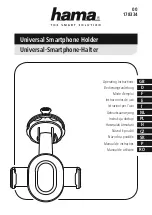
ELECTRIC VEHICLE MANAGEMENT SYSTEM V3
ZERO EMISSION VEHICLES AUSTRALIA
Specifications
Power supply: 12V nominal (8-16V maximum)
•
Power consumption: Approx 35mA when active (EVMS only), 3mA when sleeping
•
Fusing: Internal PTC type, 5A for power outputs, 200mA for logic I/O
•
Traction pack voltage range: 12-350VDC nominal
•
Traction pack capacity: 5-1250Ah (5Ah steps)
•
Current measurement: Via CAN bus current sensor, up to ±1200A
•
CAN bus format: 250kbps 29-bit (CAN 2.0B). Other formats by request.
•
Dimensions: EVMS 120x100x40mm, Monitor 96x6 mounting foot
•
Housing: ABS plastic, approx IP44 rating (weather resistant, not waterproof)
•
Installation
The EVMS should be mounted securely using screws through the four 4mm holes on the case
flanges, in a location protected from direct water. Please note that although the housings
provide some weather protection, they are not fully waterproof, so should not be exposed
to rain or submerged in water.
The EVMS has 16 screw terminal connections on top of the case, plus dual CAN ports
and a temperature sensor input on one side. Wire gauge for most connections should be
around 16-20AWG for suitable current rating and mechanical strength. Ensure all wiring
has appropriate voltage (insulation) ratings – beware that most automotive insulated wire
is not rated for the higher voltage of EV traction circuits. The supplied fork crimp lugs are
recommended for the most reliable connections to the screw terminals.
The following diagram shows a typical schematic for a complete EVMS installation in an
electric vehicle, other than gauge outputs and Multi Purpose terminals. It may look a little
intimidating at first but should become clear as you start to wire up your own vehicle. Note
that the diagram does not show an inertia switch (crash sensor), which should be installed
between the 12V battery and the EVMS‘s 12V supply. You will also usually need to use the
key signal to switch a relay for powering auxiliary 12V devices such as brake vacuum pump,
power steering pump, water cooling pump, cabin heater, etc.
Make sure all power wiring has appropriate current and voltage (insulation) ratings, and
that fuses have appropriate DC voltage and current ratings. The EVMS has an internal self-
resetting fuse which limits the total combined current of all outputs to 5A continuous, but up
to 10A is fine intermittently (e.g when contactors are energising).
With motor controllers which manage the main contactor themselves, the Main Contactor
output from the EVMS can be wired to the controller’s Key Switch Input (KSI) so that the EVMS
is able to turn the motor controller off in the case of a low cell detected, for example.
Example Wiring Diagram
4
3




























